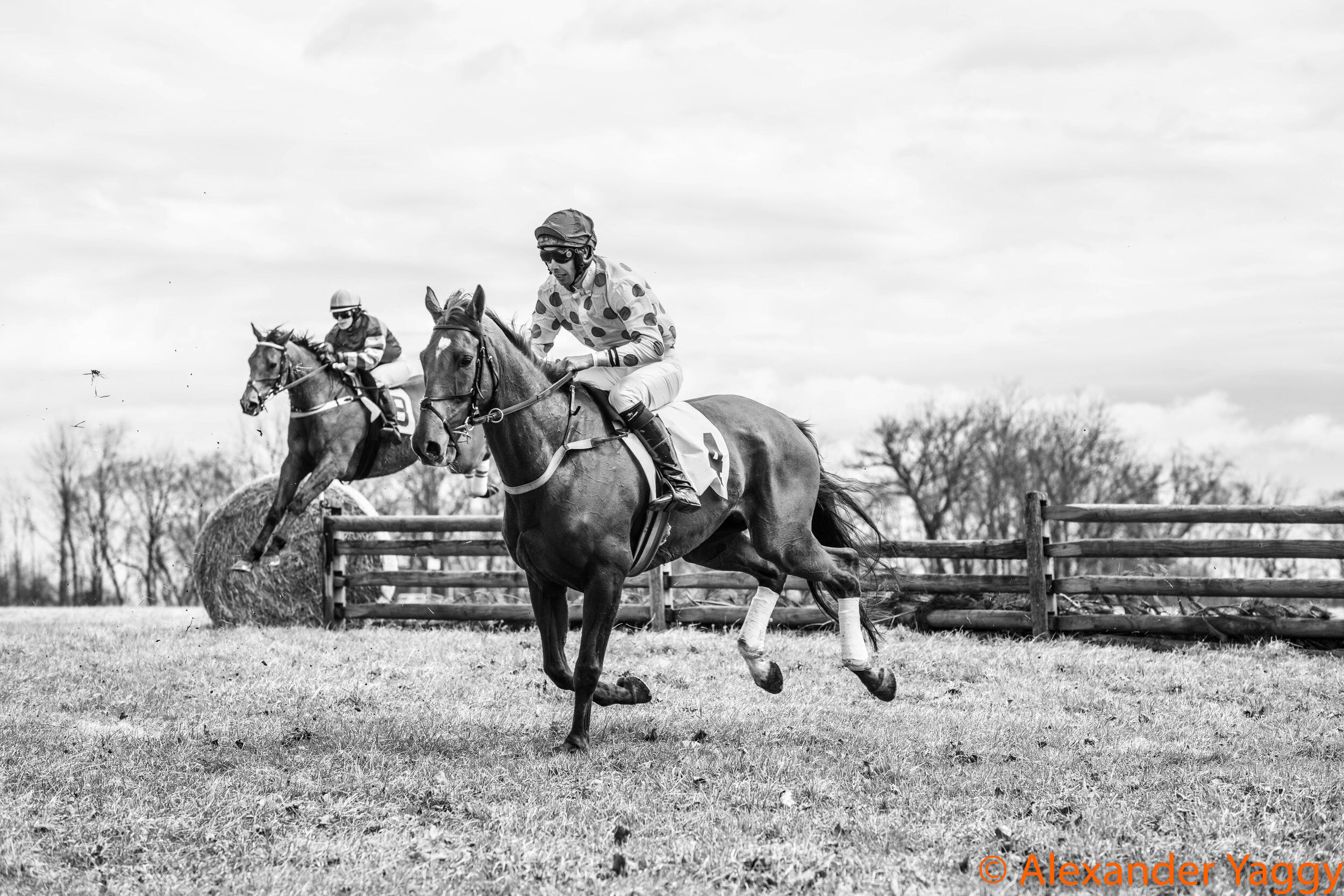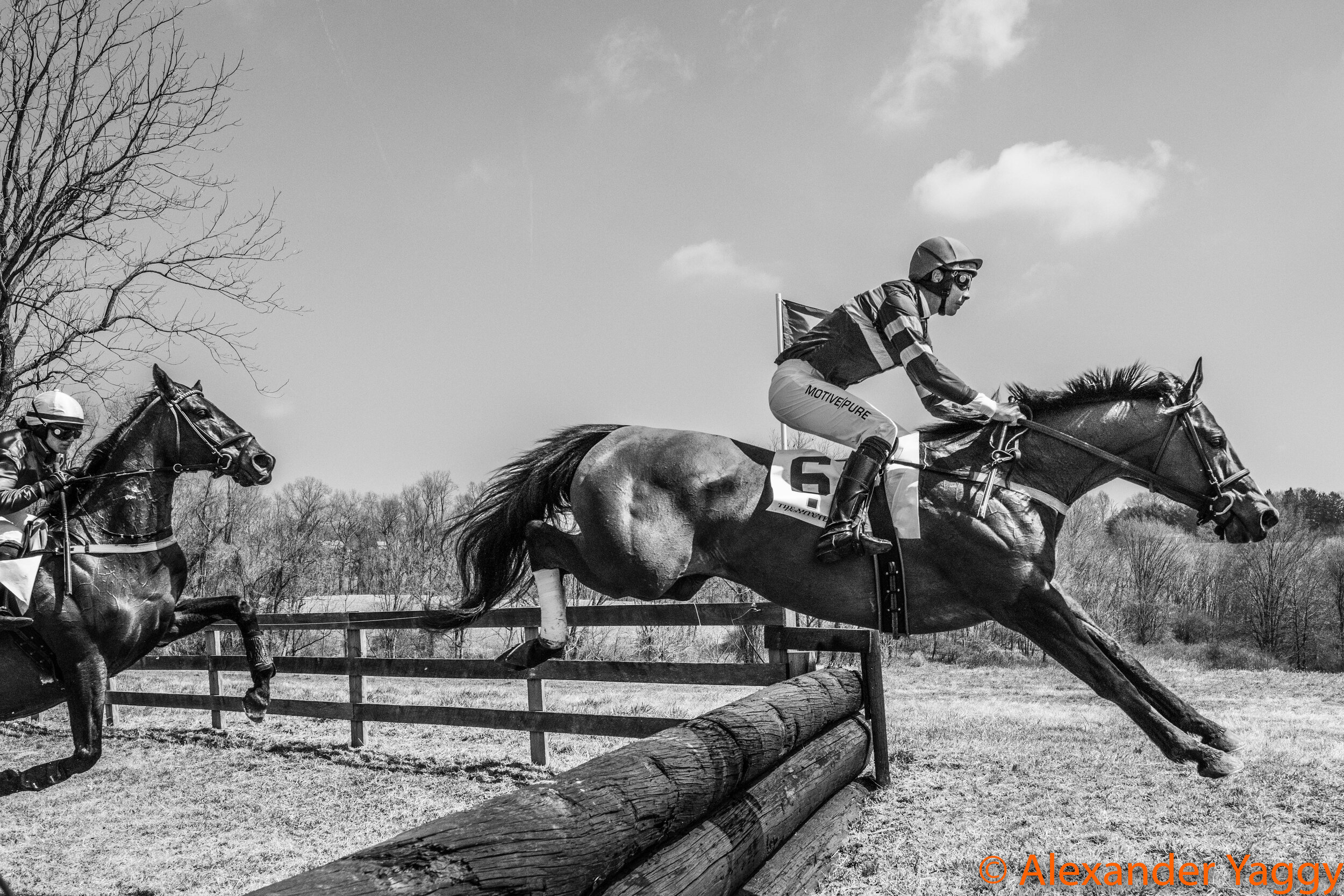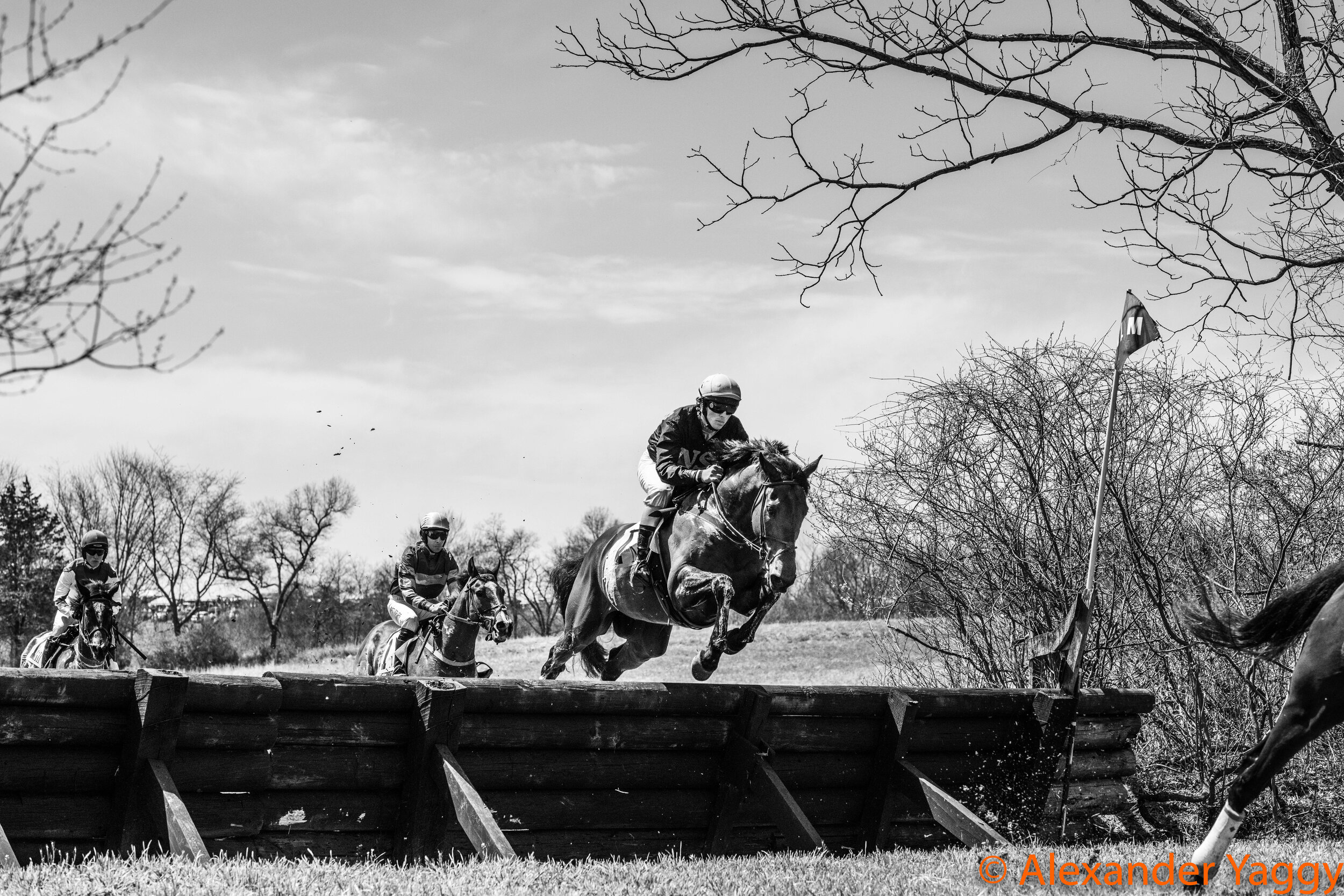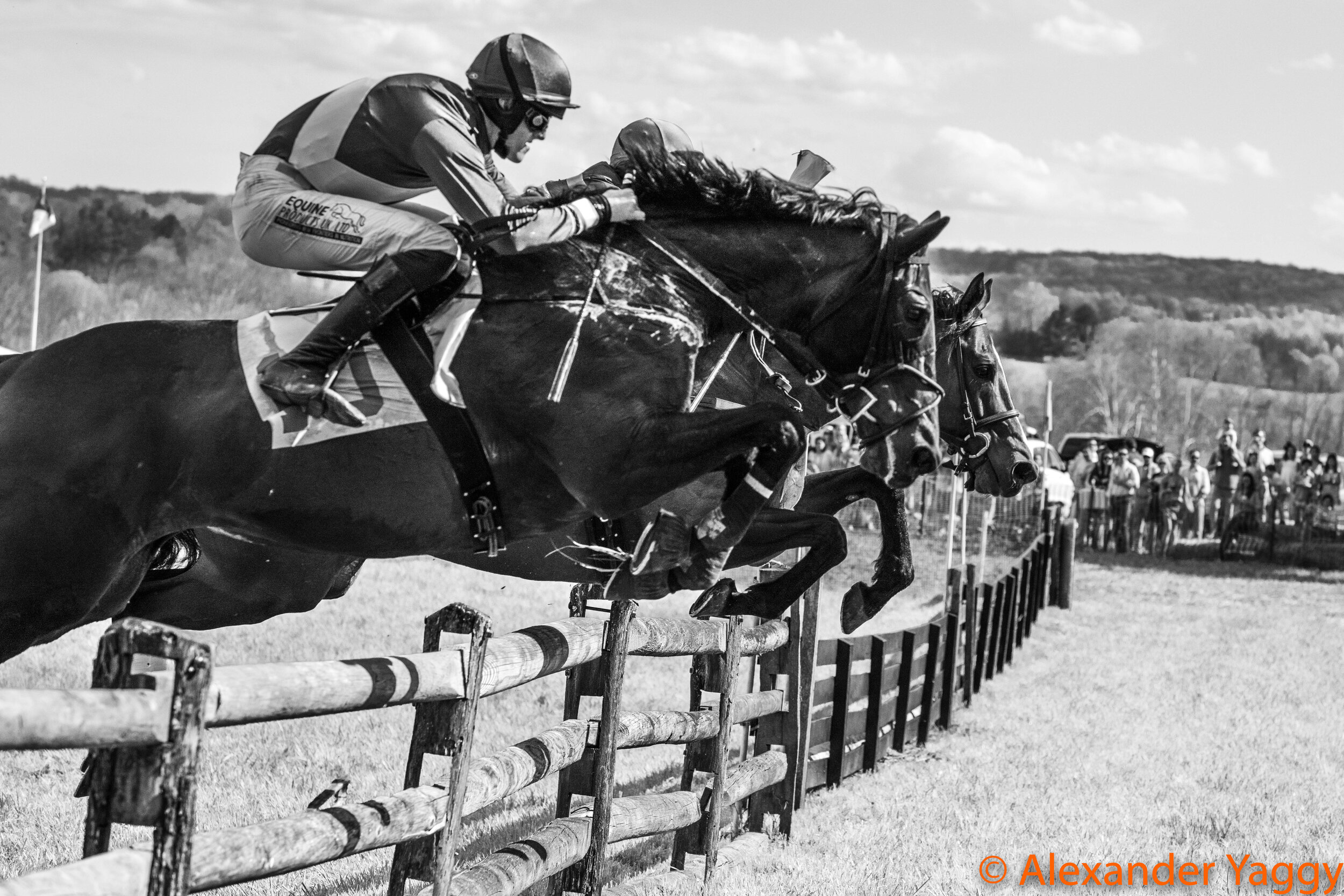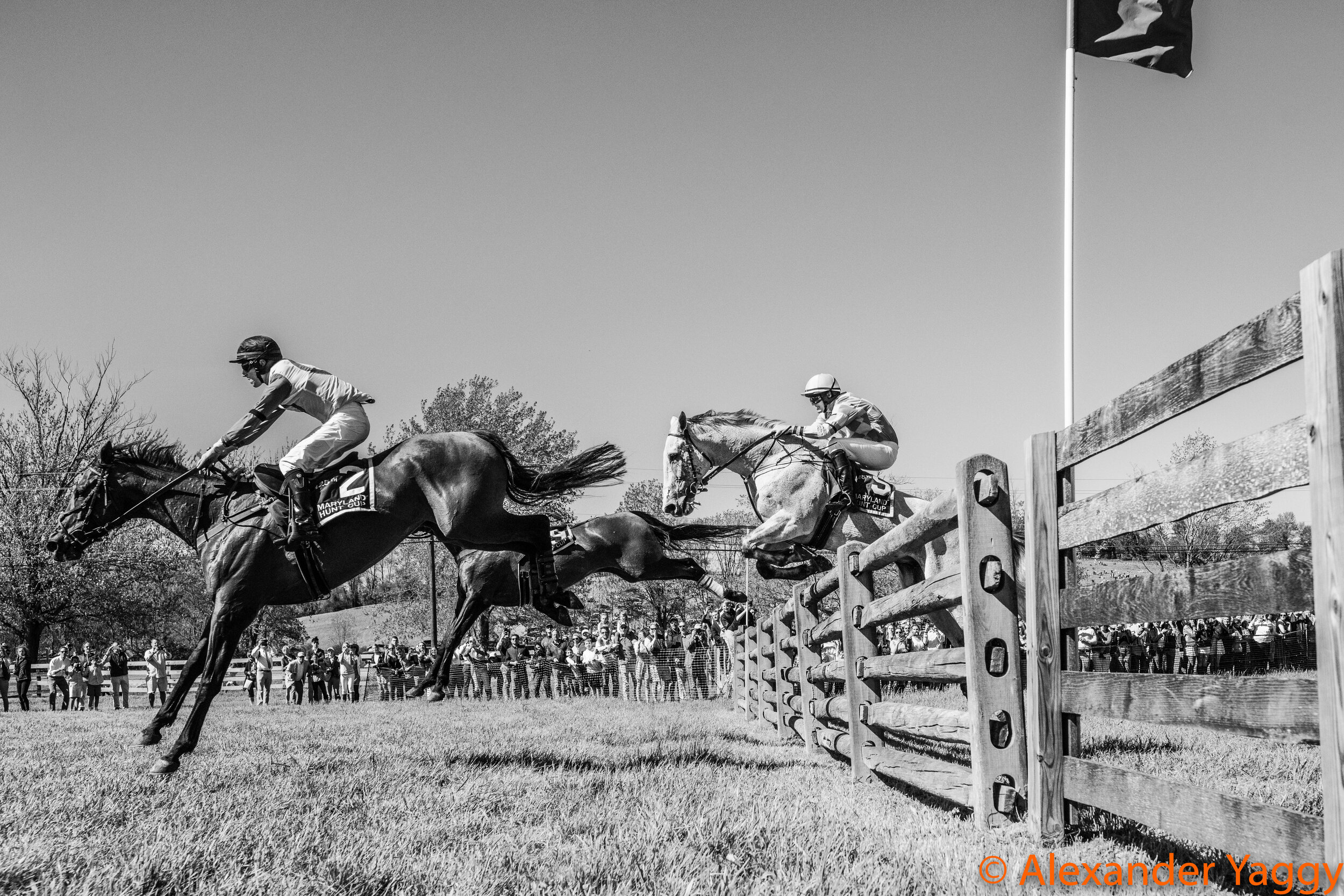Maryland Steeplechases Photographs and story by Alexander Yaggy
January 2020
Links to Galleries for each event directly below and in contents above - probably best viewed on a larger screen
I had never seen a horse jump that high. Just yards from me, Drift Society, ridden by Hadden Frost, soared over the third fence of the 2019 Maryland Hunt Cup and through the crowd of other leaping horses. Galloping at high speed, horses and riders rocketed over an obstacle nearly five feet tall, momentarily floating until their collective mass of tons of muscle and bone, with tightly coiled jockeys atop, dropped ever so briefly into the softened springtime mud. With steady hooves, the tight pack was gone in an instant and the crowd ran to a better viewing position for the next fences.
Steeplechases are spectacular events, fantastically exciting and stunningly beautiful. The crowd can be so close to the thunderous horses, raw nature, and cracking nicks on fences that there are almost no peers in the sporting world.
They occur every Spring in the Mid-Atlantic states, where weather is a squirrely affair with sometimes grey haze high above and blustery breezes. On good days the weather is shirt-sleeve comfortable with a healthy sun. Under these skies a swath from Virginia up into Pennsylvania, trailing old colonial roads, goes to the annual meets. It is, undoubtedly, a niche affair, with crowds in the five figures versus the tens of thousands for most sports events. Those that write about the races, intentionally or not, highlight the supreme WASPishness of it all: older spectators in tweeds, tents selling Barbour coats, and teens in slouchy white button downs and Hunter boots enjoying permissive tailgating picnics.
The tablecloths and candles in fields, the vintage autos, the sundresses; those things are all there and not without their pretentiousness. In 2015, Gawker.com published an article about the Hunt Cup as the Freddie Gray riots burned in my hometown of Baltimore. It torched the crowd instead for being, at best, ambivalent about the spectacle twenty miles away. The comments online, some of which are from people I knew, did the same. At the same time, it was yet another article that only focused on the crowd, the perceived wealth, and the party rather than the grand sporting event it is.
There is no escaping the timeless nature of the sport. Modest changes of better safety equipment for the riders are about the extent of the evolution. At the same time, the ever-present threat that one day the land will cease to be available does exist. Every year, in its own way, has the feel of finite existence as housing rises across cleared fields and interest in the sport wanes. Steeplechases have their origins in Ireland, where contests were over hill and vale, actual races from steeple to steeple. There is much history in them, and in this country many families are long participants as both jockeys and horse owners. The races themselves usually take place on large farms vast enough to contain three to four miles of looping courses over nearly two dozen fences. Yet the races endure, with the classic equestrian’s look, the leather tack for the horses, and bright scarlet jackets on riders astride magnificent creatures with deep eyes, strong muscles, and souls you’d swear are your better.
The field between the 5th and 6th fence at the Elkridge Harford Point to Point shows the marks of hooves on the early spring grass of Atlanta Hall Farm
Core to the sport is an appreciation of the land. In as much as a stadium conquers the land, steeplechases conform to it, with the undulating hills as they are, and the obstacles simple fences in open meadows and barriers within hedgerows.
The first of the Maryland races, The Greenspring Point-to-Point, was held at Shawan Downs, an old farm near Hunt Valley, Maryland, in March last year. It is on land I passed many times in the back seat of station wagons for school carpools while it was still a working farm. The first event, a pony race with young kids barreling down a short track, was a quick affair, with most kids bouncing along a short course while a few blazed past who clearly had the fortitude to handle the risk and the appetite for speed. The following races were some with no jumps, some with smaller ones, and finally the larger and breathtaking heavy timber races. By the end of the day I was nearly a mile away from the crowd hard against a tree forty feet from a jump, close enough to hear the jockeys alert each other as they approached the obstacle. The intensity of the timber races was offset by the levity of side-saddle race where women, laughing the entire way, cleared jumps sitting sideways, a ridiculous reminder of past society hang-ups.
I have only a hint of the challenge the riders face. At ten years old I was thrown off Raisin, a spunky dark pony with a white star on its forehead, breaking both wrists, a dramatic event on the eve of my last day of pony camp. I was back on Fresca, a larger and far more flatulent grey pony, the very next morning, my plaster casts marked by signatures and a drawing of a horse by Claire, the daughter of my instructor, upon whom I had an immense crush. I lost six weeks of summer play. The consequences for steeplechase jockeys are far more severe; horses can stumble, boots can slip, and lost balance can lead to a tumble, sometimes with crushed bodies and broken vertebrae.
Being amidst all the participants was one of the most rewarding parts of the journey I took this Spring to photograph these races. Who are these seemingly insane men and women who mount a horse, held aloft only by half-inch-wide stirrups while clutching two leather straps to guide animals ten times their weight at full speed over fences as high as cars? Usually young, all lean, handsome and beautiful, funny and intense, they are a mixture of local equestrians and cavalier Irishmen. Their pure white breeches coupled to violently colorful silks break the drab post-winter landscape. They seem confident and unbreakable, but at every race there is a wheelchair or two operated by jockeys who have fallen hard to never walk again. Maybe one can judge the crowd, but you must respect the riders’ stalwart journey across dangerous territory.
One week after The Green Spring Point-to-Point, I was crouched behind a tree, my field of view to the right full of prickly brambles while my left knee rested in the cool spring earth. I was a mile from the crowd but in the middle of the Elkridge-Harford meet. The sun was behind my left shoulder and the fence square in front of me. Springtime birds called in the branches above me. I couldn’t hear racers yet, but I could just make out the tops of helmets skittering over a grassy rise several hundred feet away. As they rounded the curved land, they left my vision behind the brush while the hooves began to get louder, louder still, and then silent before landing smoothly on the damp soil and thundering on. I would not see them until a few milliseconds before they reached the fence. I shot several dozen photos in quick bursts; I’d look at them later, first I had to run up to the chicken coop for their next pass a few minutes later.
I attended five meets over successive weekends: The Greenspring Point-to-Point; The Elkridge-Harford Point-to-Point; My Lady’s Manor; The Grand National; and The Hunt Cup, all in Maryland. As the weeks rolled on, I became more comfortable in the crowd and more knowledgeable in the field. I had running conversations with people riding in the races, working for races, managing the scales, other photographers, and spectators. I met new people and reacquainted myself with others I hadn’t seen in thirty years. Charlie Fenwick is one, a former carpool mate and a winner himself of many of these races. He writes springtime notes about the horse racing season leading up to the Kentucky Derby.
He wrote, “Seasons are God’s way of making you hard, ready to endure life’s challenges and adapt.” Winter retreats and spring brings new vitality. “In the Lenten season, rebirth through death is a good thing.”
The phrases made great sense then, and now. This was a photography project and a personal journey. I grew up in that countryside and have a deep kinship with that Maryland earth – a special sibling with which I have a deep bond. Yet, my parents quasi-farm is on the market and those home fields will soon be lost to us. My own future was then in turmoil with a hard-fought career winding down as my industry evolved and replaced humans with computers. Truly, in this Lenten season, rebirth through death. While all of us need to keep adapting to machines, this sport’s anachronistic reliance upon fragile humans as guides, horses as brute force, and pieces of trees as obstacles makes our plastic reality seem vacuous as compared to these full five-senses events.
Competitors flying over the third fence at the 2019 Hunt Cup, a nearly five foot tall obstacle. Closest is Our Town ridden by McLane Hendriks, Drift Society (3) is ridden by Hadden Frost.
A few weeks later, the season was at an end. The starter readied the Hunt Cup field and I approached the judge at the 13th fence to get direction for my placement. I stood with the veterinarian to aid any fallen horse and an ER physician ready to aid fallen riders for a moment of instruction from the Patrol Judge. This particular fence is passed twice on the race. Early in the race, the horses go fast, but with taut reins to help last the duration. By the time of the second pass, the finish is near, reins are loosened, the speed and intensity is tremendous. The caution and the curbs are lifted as the prize is within reach. Fences create such uncertainty anyone can lose or win at any moment.
It is a very high obstacle and people get hurt here. With a stone in my stomach I crouched just past the fence and waited, the racers hidden from me by the crowd and rippling fields. William O’Keefe, the announcer on top of the hill, narrated the meet. Senior Senator had won the previous races and was the favorite - but the race was tight. O’Keefe’s excited updates, in a voice knowable to anyone who has been to any local steeplechase, foretold a close finish and wound me up. With a tight pack, every fence could upset the order.
“And they’re off…” O’Keefe’s voice rolling over the fields marked the start.
Senior Senator took an early lead, though Our Town and Drift Society held tight in second and third. Prime Prospector made a move early but refused the third fence forcing the rider off. Battle Array, Derwin’s Prospector, and Joshua G.were in the chase. Battle Array’s jockey, a young rider in his first season of sanctioned racing, was out at the 11th after slipping on the landing. Joshua G held tight but could not keep pace. After the 16th, Senior Senator had a nearly ten length lead over the group but going into the 17th it was just five. Horses were tiring after over three miles. Drift Society and Our Town were closing the gap. It was two and a half at the 18th with Our Town in second and Drift Society third. Going into the 19th, Drift Society moved into second. O’Keefe’s voice rose a touch at every fence. Spectators were riled as the race tightened. The crowd gasped when Our Town stumbled on landing the 19th and rider and horse went down. As the crowd watched both rise it turned as O’Keefe exclaimed “we have a new leader,” when Drift Societyovertook the favorite Senior Senator.
William O’Keefe at the top of the hill overlooking the 2019 running of the Maryland Hunt Cup. His distinctive voice has been calling the races for more than two decades,
An hour earlier, Eric Poretz, now riding Senior Senator, and Hadden Frost, now astride Drift Society, were joking about in the back of a farm truck. “Hurry up Eddie, some of us have a race to run,” shouted Hadden at Eddie, another jockey, who was taking his time to get on their transport to the barn and mount their rides. All smiles as they and the other competitors posed for photographers during the race briefing.
For my part, I was now running frantically through the spring tufts of grass. After the small horde of horses cleared the 13th fence, the judge, the ER doctor, the vet and I all looked at each other and simultaneously exclaimed, “that was amazing!” I immediately took off, jumping a fence, scrambling through a muddy ditch, and running through the grass parking lot. Standing atop a refurbished Army medic truck complete with TVs and beer taps, Dave, who I had gotten to know over the weeks, shouted, “Run Alex, Run” as I kicked the half mile to the finish wire. In heavy boots, carrying what felt like twenty pounds of camera and lens, I sprinted past revelers, dodging cornhole courts, young women in floral dresses with red solo cups of wine, and young boys in khaki with lacrosse sticks while both laughing at my Forest Gump crossed with Ferris Bueller moment and full of joy for the moments I was witness to.
O’Keefe’s “We have a new leader” was echoing across the fields as I made it to the line, pushed my way to the finish tower and climbed a dozen feet into the air. With one arm wrapped around the cross bars, and the other lifting my camera, I hung off the side of the wobbly scaffolding while the horses kept advancing at great pace directly towards me.
The two lead horses accelerated and cleared the 20th. Further gasps as Senior Senator slipped on a mulch covered road, kicking up a pile of dust, yet dug in to stay close to the lead. With just two fences left the leaders pushed hard. At the 21st Drift Society kept his lead but Senior Senator was just two lengths behind and not surrendering. With breakneck galloping and gathering exhilaration in the crowd, the breach tightened still. The very definition of ‘neck-and-neck’ into the 22nd.
Senior Senator, ridden by Eric Poretz, dashes under the wire to win the 2019 Maryland Hunt Cup.
Senior Senator, full of furious energy, bounded over the 22nd fence and convincingly regained the lead at the apex over the fence, never to give it up for the remaining yards. The crowd was screaming as I watched Eric raise his arm under the wire through my Nikon’s viewfinder. Jumping off the scaffolding it was nothing but elation. I landed directly adjacent with one of the jockey’s from previous weeks. We hadn’t ever spoken but we gave each other an excited hug after such an astounding finish and walked arm and arm for a brief flash.
In my newfound wandering in this circle, I knew that she, with several others in that tight crowd, had lost a dear friend and fellow rider, Mark ‘Stix’ Griffiths, just days previously in a car accident. As the jockeys rolled into the paddock, healthy, intact, and smiling, a gentleman grabbed me and asked me to take a photo of the backside of Jefferey G’sjockey, Forrest Kelly. He was wearing their lost friend’s riding pants, with ‘Stix’ knitted at the top. The gentleman and Forrest embraced tightly with damp eyes.
This instant captured so much of what I had not known weeks earlier. The races are a highly authentic and human sporting event, respectably bound to tradition and ruled by natural curves of the land rather than encounters with no natural analog. In that moment, celebration and mourning, all about it was wonderful.
I went into these races with the goal of photographing amazing scenes of magnificent animals and brave riders meshing grace and power. On the surface, it was an always ‘hope-to-do’ project I now had the time to pursue. But it was also a needed distraction from the difficult acceptance that my life’s work was less relevant in a computer-coded era. What I unearthed in those fields was an extrovert I never knew I had within me, a reconnection with people I hadn’t seen in decades, and connections with people I had never met before – all of whom were amazingly generous. There were also other spectators just like me who barely ride but grow just as emotional about these fleeting moments of flight. Every sport working to cure its flaws, whether through strike zone computers, replay review, or quantitative decision-making, is correcting error but eliminating the very passion that makes anyone care about a sport. Steeplechases are not for everyone, but this old-fashioned sport, with high risk and only modest rewards, are a battlement against the creeping computational leviathans encroaching on us all.
After a few seconds and flashbulbs in the winner’s circle, it was over. The races were finished, and now life’s obligations required me to cross my own finish line with a job I was interviewing for. I stood in the sun, looked over the fields one more time; the crowds, the exhausted horses, new friends, and enjoyed the remaining brief escape I had attained from routine.
Dragging my tired self, with bruised feet from running in hiking boots, back to my car, I discovered I had parked next to one of the grand parties of excess. The picnic table had a wonderful tablecloth adorned with flowers and silver candlesticks. Champagne and wine, luxurious food, and all that I had once disdained about the Hunt Cup scene.
Senior Senator’s owners are within the crowd celebrating the victorious season.
It was Senior Senator’s owners’ spread, and they were celebrating. As they should. It was a fantastic season and day, and I am grateful that they and all of the others involved in the sport keep it going. I showed them some photos of their magnificent horse flying through air, shook their hands and made my way out. Horses are expensive, the races are dangerous, and if you never see one, you will miss out on a great party and a terrific pulse-accelerating sport.
The 2020 season begins in just a few months.
All images copyright Alexander Yaggy and may not be used without permission.
Please contact directly at a@ayaggy.com for information, print, and permission requests.
Acknowledgements
Stopping for a brief chat after the race, silks in hand.
This project would never have occurred without the help of numerous people along the way. Charlie Fenwick vouched for me and started it all. Anne Litz, Kristen Tubman, Posey Obrecht, Blake Curry, Peter Fenwick, Chessie Donnelly, Brooke Boyer all helped me in the gates. Patrick Worrall gave me access to the stables. Philip Lieske and Jake Chalfin explained the workings of the scales between races, and Chase Martin put me in position for the 3rd / 13th at the Hunt Cup. Tammie Monaco, Carol Fenwick, Tony Shore, and Robert Keller all welcomed me into the photo pool and helped guide me to the right places. Most of all, thanks to these riders who tolerated my ever-present camera, in alphabetical order: Bethany Baumgardner, Mark Beecher, John Brophy, Paul Cawley, Hadden Frost, McLane Hendriks, Eddie Keating, Forrest Kelly, Paul O’Neill, Brett Owings, Eric Poretz, Mackenzie Rosman, Aaron Sinnott, James Slater, and Annie Yeager. None of this would have been possible without my parents Michael and Nora Yaggy who bought me my first camera in eighth grade - and several subsequent ones. My sister Laura has been an enthusiastic voice for the effort, and with her help one of these images raised funds for Endeavor Therapeutic Horsemanship (http://www.endeavorth.org) in New York State. And my wife Rebecca is the best of all for her ever-present support in all things, including editing this page and letting me leave for five weekends in a row to pursue this project while our fantastic sons, Owen and Corbett, cheered me on.


